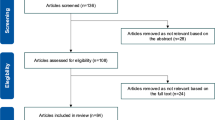Abstract
Previous literature suggests specific behavioral tendencies cause investors to deviate from optimal investing. We investigate three such tendencies in a simplified stock market. Subjects do trade for better stocks, but do not reach their maximum potential earnings, most commonly because they choose to ignore information and continue to hold on to a stock regardless of its performance. The results support the predictions of the status quo bias, but not the ostrich effect or the disposition effect.
Similar content being viewed by others
References
Benabou, R., Tirole, J.: Self-knowledge and self-regulation: an economic approach. In: Brocas, J., Carrillo, J.D. (eds.) The Psychology of Economic Decisions, vol. i. Rationality and well-being. Oxford: Oxford University Press (2002)
Bodner, R., Prelec, D.: Self-signaling and diagnostic utility in everyday decision-making. In: Brocas, J., Carrillo, J.D. (eds.) The Psychology of Economic Decisions, vol. i. Rationality and well-being. Oxford: Oxford University Press (2002)
Chui P.M.W. (2001). An experimental study of the disposition effect: evidence from Macau. J Psychol Financ Markets 2: 216–222
Galai D. and Sade O. (2006). The “ostrich effect” and the relationship between the liquidity and yields of financial assets. J Bus 79: 2741–2759
Kahneman D. and Tversky A. (1979). Prospect theory: an analysis of decision under risk. Econometrica 47: 263–291
Kahneman D. and Tversky A. (1982). The psychology of preference. Sci Am 246: 160–173
Karlsson, N., Loewenstein, G., Seppi, D.J.: The “ostrich effect”: selective attention to information about investments. SSRN working paper (2005)
Langer E.J. (1975). The illusion of control. J Pers Soc Psychol 32: 311–328
Odean T. (1998). Are investors reluctant to realize their losses?. J Financ 53: 1775–1798
Odean T. (1999). Do investors trade too much?. Am Econ Rev 89: 1279–1298
Samuelson W. and Zeckhauser R. (1988). Status quo bias in decision making. J Risk Uncertain 1: 7–59
Shefrin H. and Statman M. (1985). The disposition to sell winners too early and ride losers too long. J Finance 40: 777–790
Stracca L. (2004). Behavioral finance and asset prices: where do we stand?. J Econ Psychol 25: 373–405
Weber M. and Camerer C.F. (1998). The disposition effect in securities trading: an experimental analysis. J Econ Behav Organ 33: 167–184
Author information
Authors and Affiliations
Corresponding author
Additional information
This research is an extension of Brown’s undergraduate honors thesis at Ohio State University. Financial support was provided by the Honor’s College and the Department of Economics at Ohio State University. Kagel’s research was partially supported by grants from the National Science Foundation. We received helpful comments from Hal Arkes, David Cooper and two anonymous referees.
Rights and permissions
About this article
Cite this article
Brown, A.L., Kagel, J.H. Behavior in a simplified stock market: the status quo bias, the disposition effect and the ostrich effect. Ann Finance 5, 1–14 (2009). https://doi.org/10.1007/s10436-007-0092-0
Received:
Accepted:
Published:
Issue Date:
DOI: https://doi.org/10.1007/s10436-007-0092-0




